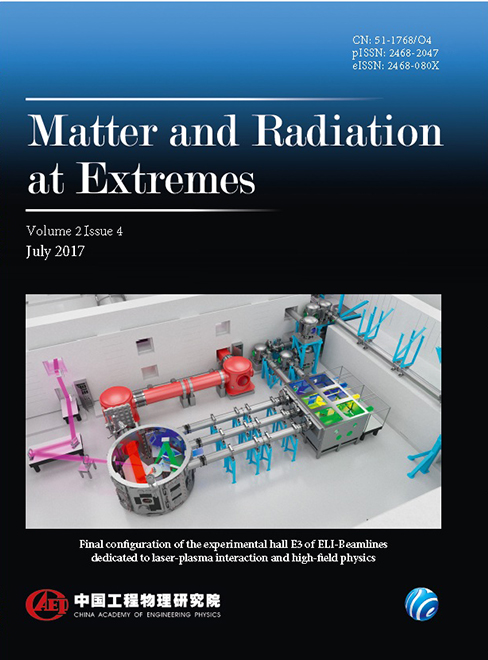
There is a misprint in the text of Figs. 3 and 4. The text on the bottom part of Figs. 3 and 4 should be “100 fs pulse Photoexcitation” and “1 fs pulse Photoexcitation” respectively. This error does not affect any conclusions in this work, and it has been corrected in the printed version of the journal.
Corrigendum Text: On page 2 of this letter, there is a misprint in the unit. The unit of the geometrical dimension of the spherical hohlraums on this page should always be “mm” rather than “mm”, i.e. in the second paragraph, “…with 800 J per beam at 0.35 mm…” should be “…with 800 J per beam at 0.35 μm…”, “The slit of 400 mm width is parallel…” should be “The slit of 400 μm width is parallel…”, “The laser focal diameter is about 500 mm…” should be “The laser focal diameter is about 500 μm…”; in the third paragraph, “…we take 850 μm as the radius…” should be “…we take 850 mm as the radius…”, “The LEH radius RL is 400 mm…” should be “The LEH radius RL is 400 μm…”, “…the radius of the cylindrical LEH outer ring is taken as 1.5 RL = 600 mm” should be “…the radius of the cylindrical LEH outer ring is taken as 1.5 RL = 600 μm”. This mistake does not affect any of the main results of the original letter.
The electron capture in N5+-H collisions imbedded in a Debye plasma is studied by using the two-center atomic orbital close-coupling method in the energy range from 1 keV/u to 200 keV/u. The atomic orbitals and electron binding energies of atomic states are calculated within the DebyeeHuckel approximation of the screened Coulomb potential and used in atomic orbital close-coupling dynamics formalism to calculate the electron capture cross sections. The electron capture cross sections and the charge transfer spectral lines of N4+(1s2nl) for a number of representative screening parameter values are presented and discussed. It is found that the screening of Coulomb interactions affects the entire collision dynamics and the magnitude and energy behavior of state-selective cross sections. The changes in electron binding energies and capture cross sections when the interaction screening varies introduce dramatic changes in the radiation spectrum of N4+(1s2nl) capture states with respect to the unscreened interaction case.
In this paper we introduce the wide regime equation of state (WEOS) developed in Institute of Applied Physics and Computational Mathematics (IAPCM). A semi-empirical model of the WEOS is given by a thermodynamically complete potential of the Helmholtz free energy which combines several theoretical models and has some adjustable parameters calibrated via some experimental and theoretical data. The validation methods of the equation of state in wide regime are presented using copper as a prototype. The results of the WEOS are well consistent with the available theoretical and experimental data, including ab initio cold curve under compression, isotherm, Hugoniot, off- Hugoniot and sound velocity data. It enhances our confidence in the accuracy of the WEOS, which is very important for the validation and verification of equation of state in high temperature and pressure technology.
In this review paper on heavy ion inertial fusion (HIF), the state-of-the-art scientific results are presented and discussed on the HIF physics, including physics of the heavy ion beam (HIB) transport in a fusion reactor, the HIBs-ion illumination on a direct-drive fuel target, the fuel target physics, the uniformity of the HIF target implosion, the smoothing mechanisms of the target implosion non-uniformity and the robust target implosion. The HIB has remarkable preferable features to release the fusion energy in inertial fusion: in particle accelerators HIBs are generated with a high driver efficiency of ~30%-40%, and the HIB ions deposit their energy inside of materials. Therefore, a requirement for the fusion target energy gain is relatively low, that would be ~50-70 to operate a HIF fusion reactor with the standard energy output of 1 GWof electricity. The HIF reactor operation frequency would be ~10-15 Hz or so. Several-MJ HIBs illuminate a fusion fuel target, and the fuel target is imploded to about a thousand times of the solid density. Then the DT fuel is ignited and burned. The HIB ion deposition range is defined by the HIB ions stopping length, which would be ~1 mm or so depending on the material. Therefore, a relatively large density-scale length appears in the fuel target material. One of the critical issues in inertial fusion would be a spherically uniform target compression, which would be degraded by a non-uniform implosion. The implosion non-uniformity would be introduced by the Rayleigh-Taylor (R-T) instability, and the large densitygradient- scale length helps to reduce the R-T growth rate. On the other hand, the large scale length of the HIB ions stopping range suggests that the temperature at the energy deposition layer in a HIF target does not reach a very-high temperature: normally about 300 eV or so is realized in the energy absorption region, and that a direct-drive target would be appropriate in HIF. In addition, the HIB accelerators are operated repetitively and stably. The precise control of the HIB axis manipulation is also realized in the HIF accelerator, and the HIB wobbling motion may give another tool to smooth the HIB illumination non-uniformity. The key issues in HIF physics are also discussed and presented in the paper.








